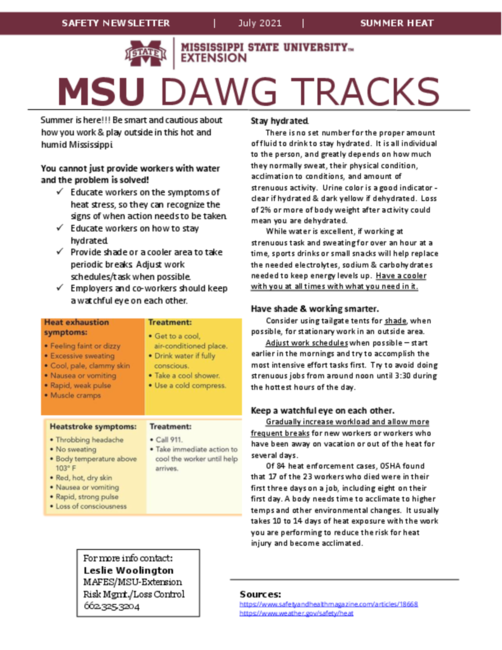Dawg Tracks Safety Talk
Summer Heat
Summer is here!!! Be smart and cautious about how you work & play outside in this hot and humid Mississippi.
You cannot just provide workers with water and the problem is solved!
✓ Educate workers on the symptoms of heat stress, so they can recognize the signs of when action needs to be taken.
✓ Educate workers on how to stay hydrated.
✓ Provide shade or a cooler area to take periodic breaks. Adjust work schedules/task when possible.
✓ Employers and co-workers should keep a watchful eye on each other.
Stay hydrated.
There is no set number for the proper amount of fluid to drink to stay hydrated. It is all individual to the person, and greatly depends on how much they normally sweat, their physical condition, acclimation to conditions, and amount of strenuous activity. Urine color is a good indicator - clear if hydrated & dark yellow if dehydrated. Loss of 2% or more of body weight after activity could mean you are dehydrated.
While water is excellent, if working at strenuous task and sweating for over an hour at a time, sports drinks or small snacks will help replace the needed electrolytes, sodium & carbohydrates needed to keep energy levels up. Have a cooler with you at all times with what you need in it.
Have shade & working smarter.
Consider using tailgate tents for shade, when possible, for stationary work in an outside area.
Adjust work schedules when possible – start earlier in the mornings and try to accomplish the most intensive effort tasks first. Try to avoid doing strenuous jobs from around noon until 3:30 during the hottest hours of the day.
Keep a watchful eye on each other.
Gradually increase workload and allow more frequent breaks for new workers or workers who have been away on vacation or out of the heat for several days.
Of 84 heat enforcement cases, OSHA found that 17 of the 23 workers who died were in their first three days on a job, including eight on their first day. A body needs time to acclimate to higher temps and other environmental changes. It usually takes 10 to 14 days of heat exposure with the work you are performing to reduce the risk for heat injury and become acclimated.
| Heat exhaustion symptoms: | Treatment: |
|---|---|
|
|
| Heatstroke symptoms: | Treatment: |
|---|---|
|
|
For more info, contact Leslie Woolington - MAFES/MSU-Extension Risk Mgmt./Loss Control 662.325.3204
